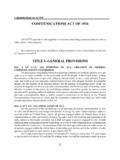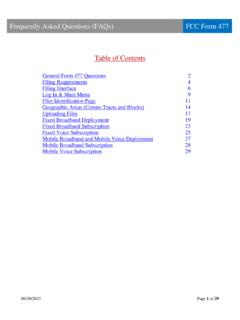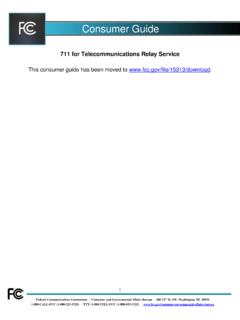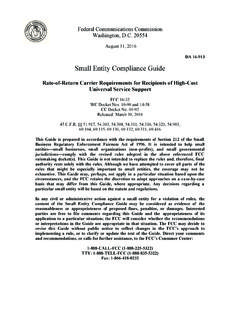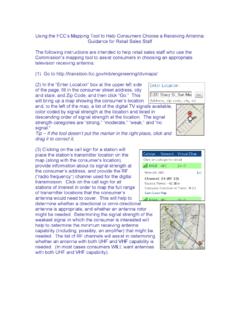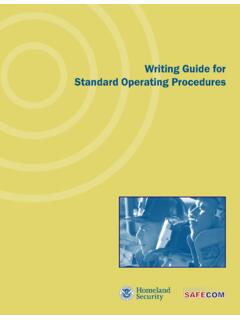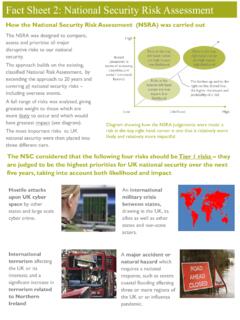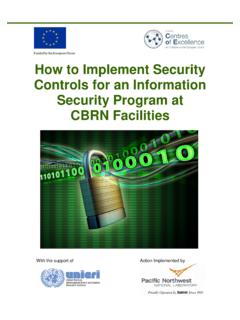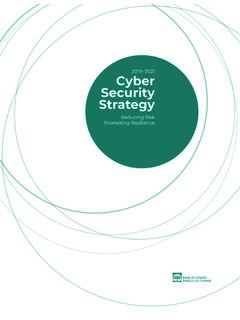Transcription of Cyber Security Planning Guide
1 The below entities collaborated in the creation of this Guide . This does not constitute or imply an endorsement by the FCC of any commercial product, service or enterprise of these entities. This Guide is not a substitute for consulting trained Cyber Security professionals. Cyber Security Planning Guide TC-1 Table of Contents Section Page #s Thank you for using the FCC s Small Biz Cyber Planner, a tool for small businesses to create customized Cyber Security Planning guides. Businesses large and small need to do more to protect against growing Cyber threats. As larger companies take steps to secure their systems, less secure small businesses are easier targets for Cyber criminals. This Planning Guide is designed to meet the specific needs of your company, using the FCC s customizable Small Biz Cyber Planner tool.
2 The tool is designed for businesses that lack the resources to hire dedicated staff to protect their business, information and customers from Cyber threats. Even a business with one computer or one credit card terminal can benefit from this important tool. We generally recommend that businesses using more sophisticated networks with dozens of computers consult a Cyber Security expert in addition to using the Cyber planner. The FCC provides no warranties with respect to the guidance provided by this tool and is not responsible for any harm that might occur as a result of or in spite of its use. The guidance was developed by the FCC with input from public and private sector partners, including the Department of Homeland Security , the National Cyber Security Alliance and The Chamber of Commerce.
3 Privacy and Data SecurityPDS-1 - PDS-5 Scams and FraudSF-1 - SF-3 Network SecurityNS-1 - NS-3 Website SecurityWS-1 - WS-5 EmailE-1 - E-2 Mobile DevicesMD-1 - MD-3 EmployeesEMP-1 - EMP-3 Facility SecurityFS-1 - FS-2 Operational SecurityOS-1 - OS-3 Payment CardsPC-1 - PC-2 Incident Response and ReportingIRR-1 - IRR-2 Policy Development, ManagementPDM-1 - PDM-3 Cyber Security GlossaryCSG-1 - CSG-10 Cyber Security LinksCSL-1 - CSL-3 Privacy and Data Security Data Security is crucial for all small businesses. Customer and client information, payment information, personal files, bank account details - all of this information is often impossible replace if lost and dangerous in the hands of criminals. Data lost due to disasters such as a flood or fire is devastating, but losing it to hackers or a malware infection can have far greater consequences.
4 How you handle and protect your data is central to the Security of your business and the privacy expectations of customers, employees and partners. Cyber Plan Action Items: 1. Conduct an inventory to help you answer the following questions: What kind of data do you have in your business? A typical business will have all kinds of data, some of it more valuable and sensitive than others, but all data has value to someone. Your business data may include customer data such as account records, transaction accountability and financial information, contact and address information, purchasing history, buying habits and preferences, as well as employee information such as payroll files, direct payroll account bank information, Social Security numbers, home addresses and phone numbers, work and personal email addresses.
5 It can also include proprietary and sensitive business information such as financial records, marketing plans, product designs, and state, local and federal tax information. How is that data handled and protected? Security experts are fond of saying that data is most at risk when it s on the move. If all your business-related data resided on a single computer or server that is not connected to the Internet, and never left that computer, it would probably be very easy to protect. But most businesses need data to be moved and used throughout the company. To be meaningful data must be accessed and used by employees, analyzed and researched for marketing purposes, used to contact customers, and even shared with key partners.
6 Every time data moves, it can be exposed to different dangers. As a small business owner, you should have a straightforward plan and policy a set of guidelines, if you like about how each type of data should be handled, validated and protected based on where it is traveling and who will be using it. Who has access to that data and under what circumstances? Not every employee needs access to all of your information. Your marketing staff shouldn t need or be allowed to view employee payroll data and your administrative staff may not need access to all your customer information. When you do an inventory of your data and you know exactly what data you have and where it s kept, it is important to then assign access rights to that data.
7 Doing so simply means creating a list of the specific employees, partners or contractors who have access to specific data, under what circumstances, and how those access privileges will be managed and tracked. Your business could have a variety of data, of varying value, including: Customer sales records Customer credit card transactions Customer mailing and email lists Customer support information PDS-1 FCC SMALL BIZ Cyber Planning Guide PDS-2 Customer warranty information Patient health or medical records Employee payroll records Employee email lists Employee health and medical records Business and personal financial records Marketing plans Business leads and enquiries Product design and development plans Legal, tax and financial correspondence 2.
8 Once you've identified your data, keep a record of its location and move it to more appropriate locations as needed. 3. Develop a privacy policy Privacy is important for your business and your customers. Continued trust in your business practices, products and secure handling of your clients unique information impacts your profitability. Your privacy policy is a pledge to your customers that you will use and protect their information in ways that they expect and that adhere to your legal obligations. Your policy starts with a simple and clear statement describing the information you collect about your customers (physical addresses, email addresses, browsing history, etc), and what you do with it. Customers, your employees and even the business owners increasingly expect you to make their privacy a priority.
9 There are also a growing number of regulations protecting customer and employee privacy and often costly penalties for privacy breaches. You will be held accountable for what you claim and offer in your policy. That s why it s important to create your privacy policy with care and post it clearly on your website. It s also important to share your privacy policies, rules and expectations with all employees and partners who may come into contact with that information. Your employees need to be familiar with your legally required privacy policy and what it means for their daily work routines. Your privacy policy will should address the following types of data: Personally Identifiable Information: Often referred to as PII, this information includes such things as first and last names, home or business addresses, email addresses, credit card and bank account numbers, taxpayer identification numbers, patient numbers and Social Security numbers.
10 It can also include gender, age and date of birth, city of birth or residence, driver s license number, home and cell phone numbers. Personal Health Information: Whether you re a healthcare provider with lots of sensitive patient information or you simply manage health or medical information for a small number of employees, it s vital that you protect that information. A number of studies have found most consumers are very concerned about the privacy and protection of their medical records. They do not want their health information falling into the hands of hackers or identity thieves who might abuse it for financial gain. But they also may not want employees or co-workers prying into their personal health details.
